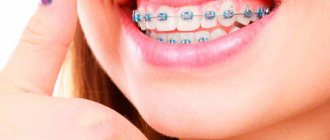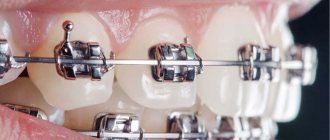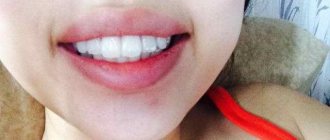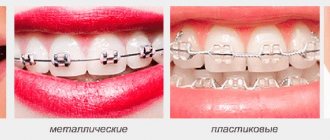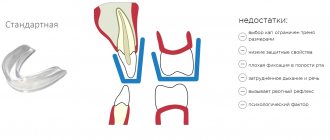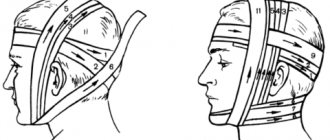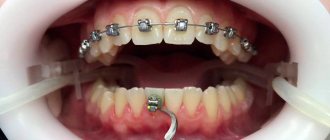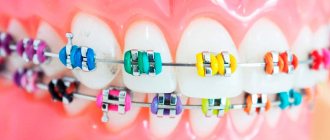Not every patient knows what a combined bracket system is. As a rule, treatment with braces is presented within the framework of the choice of one type of structure. Now you can learn in detail about the combined braces system and, perhaps, reconsider your views on correcting your bite.
A certain percentage of people consider these designs to be optimal for correcting occlusion in terms of price, quality and aesthetics. Speaking about the latter, one cannot help but notice that most often patients try to hide the presence of braces on their teeth as much as possible, sometimes agreeing to lingual braces, which cause a number of serious difficulties in everyday life.
Surely you know that braces are made from different materials. Each of them has a different impact on teeth, strength and appearance. Materials and prices vary. Most often you have to choose between the effectiveness of the treatment and the beauty of your smile, even during treatment. But how to combine the invisibility of transparent braces and the effectiveness of metal ones? More on this later.
What is a combined braces system?
So, what is a combined braces system? It is easy to guess that such a system is a composite version, which involves the presence of different materials in one design. So, on the front teeth located in the smile zone, the orthodontist installs transparent sapphire or ceramic braces that match the shade of the patient’s tooth enamel. Metal braces are installed on the remaining chewing teeth, which no one will see due to the location of these teeth.
Such bracket systems meet the most popular patient requirements:
- they are almost invisible when you smile;
- they are not very expensive;
- The effectiveness of bite correction is quite high.
But don't rush to conclusions. Combined systems are not suitable for all types of malocclusion, so you can only find out if such braces are right for you from your doctor.
Partial braces for the lower jaw: indications and recommendations
If bite defects are minor, then partial correction is acceptable. Indications for installing braces on the lower jaw:
- Crowding of the front teeth - incisors and canines.
- Slight curvature of one or more teeth.
- Diastema between the incisors with proper closure of the chewing teeth.
Doctors allow local correction of the lower row in the absence of serious bite pathologies and symmetrical position of the jaws in adolescents.
Also, a partial “4+2” brace system is often installed on the lower jaw. This is practically the only case when braces are installed for children 7-9 years old. The purpose of the orthodontic design is to quickly straighten the front permanent teeth at the time of bite change. These braces are attached to 6 points - to 4 incisors and to the last two chewing units. Treatment is carried out according to indications - after a thorough diagnosis of the bite by an orthodontist.
Dolotova Marina
In order to be able to place braces only on the lower jaw, a couple of conditions must coincide. The first is the insignificance of the anomaly. Often this is the curvature of one or two teeth. The second is initially correct occlusion, symmetrical closure. That's great rarity. In other cases, treatment is carried out in combination.
Disadvantages of combined braces
There are also disadvantages of combined bracket systems:
- the “secret” of braces can be revealed if the metal parts are in a noticeable position for others (this depends on the individual structure of the patient’s jaw);
- caring for such braces will require a little more time and effort;
- in the first weeks after installation, some disturbance of diction almost always occurs, which is corrected over time;
- Transparent braces are less durable than metal braces and therefore require careful handling.
How to install braces: treatment algorithm
Installation of the bracket system - on the lower jaw or on both at once - is carried out according to a single scheme in several stages:
- Consultation with an orthodontist. The initial examination serves as the basis for prescribing further research and for discussing the possibility of installing braces only on the lower teeth. Also at the appointment, the need for sanitation of the oral cavity and professional teeth cleaning is assessed.
- X-ray examination and image analysis. Based on the diagnostic results, the orthodontist decides on correction - braces on the lower jaw or both. Draws up a treatment plan, selects the type and material of the orthodontic system.
- Preparation of the oral cavity - elimination of all sources of infection and removal of supernumerary teeth if necessary.
- Taking impressions of the patient's jaws.
- Installation of bracket system. Preparing the surface of the teeth and fixing the plates with a special photopolymer glue. The last to be placed is the orthodontic arch.
- Familiarization with the rules of wearing braces, care and nutrition - clarifying the sequence of actions when cleaning the system and restrictions on certain products.
Rodikova Tatyana
Patients often ask to have braces placed only on the lower jaw, because they are afraid of looking ugly. If this is the only question, then we select invisible analogues - aligners or sapphire braces.
In the future, the patient comes for scheduled appointments until the braces are removed. The frequency of visits depends on the type of orthodontic structure installed:
- Ligature - elastic bands that fix the arch are changed once a month.
- Non-ligature - a metal arc requires replacement every 1.5-2 months.
After treatment is completed, the braces are removed and a retainer is placed on the lingual side of the teeth to secure the results.
Why choose combined braces?
Summarizing all the pros and cons, we will answer why combined braces are chosen. It depends on which criterion for braces is the patient’s priority. Most often, patients are guided by aesthetics. So, if in childhood braces are treated as an accessory or a game, then in adults you want to hide the fact of their presence as much as possible. Therefore, combined systems are most popular among adults and teenagers who care about their reputation. In addition, public people or those who occupy important positions also prefer the combined type.
The smile area that receives clear or ceramic braces includes the 6 front teeth on both jaws. And metal, more durable braces are placed on chewing teeth that bear a large load. Thus, bite correction allows you to combine efficiency and unobtrusiveness.
In addition, the criteria for choosing combined braces include financial ones. When a patient is ready to spend a certain amount on aesthetic clear braces, the prospect of saving money and partially replacing them with metal ones is always attractive.
And, of course, effectiveness is of great importance when choosing. The fact is that metal braces are recognized as the most effective. If the front teeth require correction, then combined braces may not be suitable. And if the main load during treatment should fall on the teeth outside the smile zone, the doctor will offer you a combined system.
Indications for use
- A compromise between functionality and aesthetics.
In case of significant curvature of the dentition, metal braces are recommended for the most effective treatment, but not everyone is ready to wear them. In this case, you can find a compromise between beauty and benefit by installing different types of systems (according to functional and aesthetic indicators) for the anterior and chewing teeth. - Each jaw has its own braces.
The case when different types of devices are used to correct the bite on different jaws. This is especially true if the lower dentition is more crooked than the upper one, and wearing metal braces is recommended to correct it. And you can safely install a more aesthetic design on your upper teeth. - Financial question.
Metal structures are often recommended for serious anomalies, but bite correction can be successfully corrected using any system. But whether there is enough money for, say, sapphire braces is a big question. In conditions of limited budget, combined systems can serve very well.
Unpleasant moments after installation
Despite all the advantages of such braces, they, like all other orthodontic structures, involve some unpleasant moments after installation.
Almost everyone who has ever been interested in the possibility of getting straight teeth knows about this today. During the consultation, the doctor will once again remind the patient about possible inconveniences during bite correction. Almost everyone experiences discomfort in the first days and weeks after installation. This is due to the unusual constant load and pressure on the teeth that braces exert. Therefore, there is no need to be afraid of an unpleasant moment: the discomfort will pass on its own.
There is also a risk of inflammation of the mucous membrane upon contact with braces and friction, but this can also be solved. Problems with diction are also easy to fix. In general, after a month, all patients get used to braces and stop noticing them.
Braces for lower teeth: prices in Moscow
The cost of orthodontic treatment depends on several points:
- The chosen system is ligature or self-ligating, lingual braces or vestibular.
- The material of the braces is metal, sapphire, ceramic. The most inexpensive are vestibular metal ligatures. They are recommended by doctors for local correction of lower teeth.
- Manufacturer company. Clarity Advanced braces, as well as many other brands, have received good reviews.
- Scope of preparatory work – treatment of caries of permanent teeth, professional hygiene.
- X-ray studies.
The range and final amount of treatment can be calculated by the doctor after conducting the necessary examinations and assessing the pathology of the bite.
Azabuka Children's Dental Clinic offers bite correction services and finds a solution to eliminate any anomalies. The clinic's orthodontists will select an orthodontic system for any patient - plates, aligners, braces - will help restore the health and beauty of teeth.
How to care for combined braces?
How to care for combined braces? First of all, you will have to brush your teeth more thoroughly; you need to use a special brush that cleans not only the teeth, but also the braces themselves. The cleaning time will increase from 2 minutes to 5–7. This should be taken for granted. After all, insufficient care about hygiene leads to caries and other consequences, which are very inconvenient to treat during orthodontic treatment.
In addition to brushing, you should use mouth rinses. This is required by the mucous membrane. As for nutrition, very hard, sticky, too hot or cold foods are prohibited. You should also stop chewing gum during treatment.
Common bite pathologies
To understand why you cannot insist on local correction of the bite, it is worth getting acquainted with the main deviations in jaw closure. The description of pathologies shows that correction should be carried out comprehensively. Otherwise, treatment will only worsen the problem, even if there are no visible prerequisites for this.
To diagnose a bite, doctors rely on photographs of the jaws - a comprehensive x-ray examination:
- OPTG (orthopantomogram) – a panoramic image of the dentofacial rows;
- CT – computed tomography of one or two jaws;
- TRG (teleradiogram) – lateral projection of the skull.
The most common malocclusions:
- Open – when the jaws are closed, there is no contact in the frontal zone or in the area of the chewing teeth.
- Deep - the lower incisors overlap the upper antagonist teeth by more than a third.
- Distal – the upper row of teeth is pushed forward.
- Mesial – the lower jaw protrudes forward.
- Crossed - the jaw rows are changed in shape or size in the horizontal direction.
Any pathology requires complex correction, since with partial displacement of teeth, the existing disproportion will only intensify. Moreover, with almost correct closure of the jaws, movements of the lower teeth can provoke a violation of occlusion - displace the cutting edges or chewing surfaces of individual units relative to each other. Visually, the teeth will become straight, but the bite will be disrupted.
Soldatenkova Alina
It is impossible to immediately say what orthodontic treatment is indicated for the patient. Just guess. A constructive dialogue begins after receiving x-rays, where you can see not just the current picture, but also hidden processes - impacted and dystopic teeth, the condition of the roots and periodontal tissues. After studying the images and OPTG, we can discuss the installation of braces on the lower jaw or another treatment option.
Stages of installation of combined bracket systems
The stages of installation of combined braces include preliminary preparation of teeth: professional cleaning and treatment in the presence of caries. To completely install the structure on your teeth, you will need to attach braces to each tooth using glue or fasteners. And also connect them to each other using an arch, which is fixed on each bracket either ligated or non-ligated. The first method involves using an elastic band, the second does not.
Each of the variations is justified by the patient’s diagnosis and financial capabilities.
Metal braces: photos “before” and “after” treatment
Orthodontists document manipulations in medical records and using a dental photo protocol. The doctor uses photographs to plan and illustrate treatment progress. After the patient has signed consent to the processing of personal data and allowed the photographs to be used for commercial purposes, the orthodontist has the right to post the photo protocol on the Internet.
photo protocol for deep bite treatment
Orthodontists publish “before” and “after” photos of braces treatment on social networks to attract new patients, show the quality of treatment and discuss clinical cases with colleagues.
Prices
| View | Set for one jaw | Installation | Installment plan |
| Metal | from 30,000 rub. | from 20,000 rub. | 7,000 - 9,000 rub./month |
| Sapphire | from 50,000 rub. | from 30,000 rub. | 10,000 rub./month |
| Ceramic | from 45,000 rub. | from 30,000 rub. | 10,000 rub./month |
| Plastic | from 40,000 rub. | from 30,000 rub. | 10,000 rub./month |
| Other types | from 40,000 rub. | from 30,000 rub. | 10,000 rub./month |
The best option
The combination can be anything, according to the wishes of the clients. Its meaning comes down to a harmonious combination of price and quality, efficiency and visual appeal of a person’s smile. After all, peace of mind (because some people - especially young people - tend to get very complex because of braces) of the patient and the absence of any unpleasant physical sensations are important.
Our dental center offers various options for braces, differing in functional properties and price. We offer to install entry-level metal braces, sapphire and ceramic braces, as well as combined systems “Incognito”, “Incognito “Lite”, “Invisiling” and “Win”.
Features of installing braces in adults, adolescents and children
Installing braces for a teenager is not much different from installing braces for an adult.
Correcting the bite in children simply happens faster. The need for treatment with braces and the appropriate age will be determined by the orthodontist. For a teenager, the cost of braces in Moscow depends on the clinic and the chosen design. Braces are not used on baby teeth. If they are placed too early, the child may be left without teeth. To install braces, you will have to wait at least 10 to 12 years until your teeth change. The age after 14 years is optimal for using braces. Treatment occurs faster than in adults and is easier to tolerate.
Parents often doubt whether teenagers should get braces. Crooked teeth can lead to health problems over time. Incorrect positioning of teeth provokes the development of caries, periodontitis, and digestive problems.
Kinds
Depending on the materials used, they can be:
- metal with ceramics;
- plastic with ceramics;
- sapphire with metal;
- sapphire with ceramics.
Depending on the purpose there are:
- system for quick bite correction. Such braces have increased strength and allow you to eliminate bite defects as quickly as possible. The plates themselves are made of plastic or ceramic and look inconspicuous, and the grooves are reinforced with metal;
- braces for the correction of moderate disorders. In this case, the Patient is offered the installation of plastic, ceramic or sapphire systems on the upper jaw. Metal braces are used for the lower jaw. Firstly, it helps to save money since metal systems are much cheaper than others, and secondly, it increases the efficiency of the system;
- combined system for correcting malocclusions of the lower jaw. If the lower teeth are much more crooked than the upper teeth, the use of ceramic, sapphire or plastic braces will not be effective. Therefore, it is better to install a metal system. On the upper jaw, you can use a different aesthetic material;
- economical system. The high cost of correction is the main disadvantage of aesthetic brace systems. Not every Patient has the financial resources to install an expensive system without compromising the budget. In this case, you can choose an inconspicuous material for the front teeth, and a more affordable metal for the side and bottom teeth.
They have a number of advantages:
- patient savings. Replacing aesthetic materials with metals significantly reduces the cost of the system;
- the effectiveness of treatment increases. Metal structures can reduce treatment time;
- selection of braces for a specific clinical case;
- the opportunity to look aesthetically pleasing during the correction period. To do this, braces made of invisible materials are installed in the most visible areas.
The price of combined braces directly depends on the number of aesthetic braces made of expensive materials in visible places and on average is:
- (sapphire + metal) – 50,000 – 80,000 rubles;
- (sapphire + ceramics) – 60,000 – 100,000 rubles;
- (metal + plastic) – 30,000 – 60,000 rubles;
- (plastic + ceramics) – 40,000 – 80,000 rub.
Installation of a combined braces system is absolutely painless and does not take much time - it usually lasts no more than two hours. Using special glue, the plates are fixed to the teeth, then a metal arch of the required rigidity is installed. Before installation, the patient undergoes a diagnostic procedure during which the nature and extent of the malocclusion is determined and treatment is prescribed. Then the MY ORT clinic specialist determines the type of system that will be installed, as well as the exact number of plates to be installed from each material.

